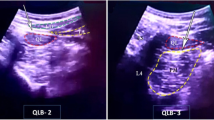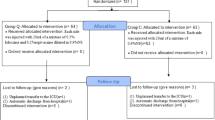Abstract
Background
Postoperative pain treatment for pediatrics is often inadequate and the evidence of pediatric postoperative analgesia is scarce. To our knowledge, no report regarding the comparison among caudal block, transversus abdominis plane (TAP) block and quadratus lumborum (QL) block for children undergoing lower abdominal laparoscopic surgery was found at present. Thus this trial aimed to compare the efficacies of them for children undergoing lower abdominal laparoscopic surgery.
Methods
One hundred and eighty children aged from 1 to 12 years undergoing lower abdominal laparoscopic surgery were included and randomized to receive caudal block, TAP block or QL block. The primary outcome was the Face, Legs, Activity, Cry, and Consolability (FLACC) score at 30 min, 1 h, 4 h, 8 h, 12 h, and 24 h and tramadol consumption during first 24 h postoperatively. Secondary outcomes included the number of children received tramadol, time to first tramadol request, parents' satisfaction and postoperative adverse reactions.
Results
The QLB group had lower postoperative FLACC scores at 8 h (median difference − 0.43, P = 0.03) than the Caudal group and at 4 h (median difference − 0.6, P = 0.001) and 8 h (median difference − 0.43, P = 0.03) than the TAPB group. The tramadol consumption was lower in the QLB group (28.43 ± 6.55) than the TAPB group (37.17 ± 6.12, P = 0.023). Although the number of children received tramadol did not differ among the three groups, the time to first tramadol request was longer in the QLB group (7.20 ± 0.79) than the caudal group (8.42 ± 0.61, P = 0.008). No statistical difference was observed concerning other secondary outcomes.
Conclusions
QLB produced more effective postoperative analgesia for children undergoing laparoscopic abdominal surgery compared with the TAPB and caudal block.
Graphical abstract


Similar content being viewed by others
References
Tao B, Liu K, Wang D, Ding M, Yang N, Zhao P (2019) Perioperative effects of caudal block on pediatric patients in laparoscopic upper urinary tract surgery: a randomized controlled trial. BMC Pediatr 19:427
Kauffman JD, Nguyen ATH, Litz CN, Farach SM, DeRosa JC, Gonzalez R, Amankwah EK, Danielson PD, Chandler NM (2020) Laparoscopic-guided versus transincisional rectus sheath block for pediatric single-incision laparoscopic cholecystectomy: a randomized controlled trial. J Pediatr Surg 55:1436–1443
Mostafa MF, Hamed E, Amin AH, Herdan R (2021) Dexmedetomidine versus clonidine adjuvants to levobupivacaine for ultrasound-guided transversus abdominis plane block in paediatric laparoscopic orchiopexy: randomized, double-blind study. Eur J Pain 25:497–507
Boric K, Dosenovic S, Jelicic Kadic A, Batinic M, Cavar M, Urlic M, Markovina N, Puljak L (2017) Interventions for postoperative pain in children: an overview of systematic reviews. Paediatr Anaesth 27:893–904
Brenner L, Marhofer P, Kettner SC, Willschke H, Machata AM, Al-Zoraigi U, Lundblad M, Lönnqvist PA (2011) Ultrasound assessment of cranial spread during caudal blockade in children: the effect of different volumes of local anaesthetics. Br J Anaesth 107:229–235
Sethi N, Pant D, Dutta A, Koul A, Sood J, Chugh PT (2016) Comparison of caudal epidural block and ultrasonography-guided transversus abdominis plane block for pain relief in children undergoing lower abdominal surgery. J Clin Anesth 33:322–329
Tran DQ, Bravo D, Leurcharusmee P, Neal JM (2019) Transversus abdominis plane block: a narrative review. Anesthesiology 131:1166–1190
Blanco R, Ansari T, Riad W, Shetty N (2016) Quadratus lumborum block versus transversus abdominis plane block for postoperative pain after cesarean delivery: a randomized controlled trial. Reg Anesth Pain Med 41:757–762
Dam M, Hansen CK, Børglum J, Chan V, Bendtsen TF (2016) A transverse oblique approach to the transmuscular quadratus lumborum block. Anaesthesia 71:603–604
Öksüz G, Bilal B, Gürkan Y, Urfalioğlu A, Arslan M, Gisi G, Oksuz H (2017) Quadratus lumborum block versus transversus abdominis plane block in children undergoing low abdominal surgery: a randomized controlled trial. Reg Anesth Pain Med 42:674–679
Pirrera B, Alagna V, Lucchi A, Berti P, Gabbianelli C, Martorelli G, Mozzoni L, Ruggeri F, Ingardia A, Nardi G, Garulli G (2018) Transversus abdominis plane (TAP) block versus thoracic epidural analgesia (TEA) in laparoscopic colon surgery in the ERAS program. Surg Endosc 32:376–382
Chin KJ, McDonnell JG, Carvalho B, Sharkey A, Pawa A, Gadsden J (2017) Essentials of our current understanding: abdominal wall blocks. Reg Anesth Pain Med 42:133–183
Sato M (2019) Ultrasound-guided quadratus lumborum block compared to caudal ropivacaine/morphine in children undergoing surgery for vesicoureteric reflex. Paediatr Anaesth 29:738–743
Dam M, Hansen CK, Poulsen TD, Azawi NH, Wolmarans M, Chan V, Laier GH, Bendtsen TF, Børglum J (2019) Transmuscular quadratus lumborum block for percutaneous nephrolithotomy reduces opioid consumption and speeds ambulation and discharge from hospital: a single centre randomised controlled trial. Br J Anaesth 123:e350–e358
Ueshima H, Otake H, Lin JA (2017) Ultrasound-guided quadratus lumborum block: an updated review of anatomy and techniques. Biomed Res Int 2017:1–7
Ishio J, Komasawa N, Kido H, Minami T (2017) Evaluation of ultrasound-guided posterior quadratus lumborum block for postoperative analgesia after laparoscopic gynecologic surgery. J Clin Anesth 41:1–4
Fujimoto H, Irie T, Mihara T, Mizuno Y, Nomura T, Goto T (2019) Effect of posterior quadratus lumborum blockade on the quality of recovery after major gynaecological laparoscopic surgery: a randomized controlled trial. Anaesth Intensive Care 47:146–151
Suresh S, Ecoffey C, Bosenberg A, Lonnqvist PA, de Oliveira GS Jr, de Leon Casasola O, de Andrés J, Ivani G (2018) The European society of regional anaesthesia and pain therapy/american society of regional anesthesia and pain medicine recommendations on local anesthetics and adjuvants dosage in pediatric regional anesthesia. Reg Anesth Pain Med 43:211–216
Wiegele M, Marhofer P, Lönnqvist PA (2019) Caudal epidural blocks in paediatric patients: a review and practical considerations. Br J Anaesth 122:509–517
Ilfeld BM, Khatibi B, Maheshwari K, Madison SJ, Esa WAS, Mariano ER, Kent ML, Hanling S, Sessler DI, Eisenach JC, Cohen SP, Mascha EJ, Ma C, Padwal JA, Turan A (2021) Ambulatory continuous peripheral nerve blocks to treat postamputation phantom limb pain: a multicenter, randomized, quadruple-masked, placebo-controlled clinical trial. Pain 162:938–955
Raval AD, Deshpande S, Koufopoulou M, Rabar S, Neupane B, Iheanacho I, Bash LD, Horrow J, Fuchs-Buder T (2020) The impact of intra-abdominal pressure on perioperative outcomes in laparoscopic cholecystectomy: a systematic review and network meta-analysis of randomized controlled trials. Surg Endosc 34:2878–2890
Yu TC, Hamill JK, Liley A, Hill AG (2013) Warm, humidified carbon dioxide gas insufflation for laparoscopic appendicectomy in children: a double-blinded randomized controlled trial. Ann Surg 257:44–53
Zhao WL, Li SD, Wu B, Zhou ZF (2021) Quadratus lumborum block is an effective postoperative analgesic technique in pediatric patients undergoing lower abdominal surgery: a meta-analysis. Pain Physician 24:e555–e563
Huang D, Song L, Li Y, Xu Z, Li X, Li C (2020) Posteromedial quadratus lumborum block versus transversus abdominal plane block for postoperative analgesia following laparoscopic colorectal surgery: a randomized controlled trial. J Clin Anesth 62:109716
Li X, Xu ZZ, Li YT, Lin ZM, Liu ZY, Wang DX (2021) Analgesic efficacy of two approaches of ultrasound-guided quadratus lumborum block for laparoscopic renal surgery: a randomised controlled trial. Eur J Anaesthesiol 38:265–274
Desai N, Chan E, El-Boghdadly K, Albrecht E (2020) Caudal analgesia versus abdominal wall blocks for pediatric genitourinary surgery: systematic review and meta-analysis. Reg Anesth Pain Med 45:924–933
Ipek CB, Kara D, Yilmaz S, Yesiltas S, Esen A, Dooply S, Karaaslan K, Turkoz A (2019) Comparison of ultrasound-guided transversus abdominis plane block, quadratus lumborum block, and caudal epidural block for perioperative analgesia in pediatric lower abdominal surgery. Turk J Med Sci 49:1395–1402
Tran TM, Ivanusic JJ, Hebbard P, Barrington MJ (2009) Determination of spread of injectate after ultrasound-guided transversus abdominis plane block: a cadaveric study. Br J Anaesth 102:123–127
Dam M, Moriggl B, Hansen CK, Hoermann R, Bendtsen TF, Børglum J (2017) The pathway of injectate spread with the transmuscular quadratus lumborum block: a cadaver study. Anesth Analg 125:303–312
Acknowledgements
We would like to thank the surgical team from the Pediatric Surgery Department, First Affiliated Hospital of Zhengzhou University for their positive cooperation in this trial.
Funding
None.
Author information
Authors and Affiliations
Corresponding author
Ethics declarations
Disclosure
Yue Zhang, Yan-Ping Wang, Hai-Tao Wang, Yu-Can Xu, Hui-Min Lv, Yang Yu, Peng Wang, Xiang-Dong Pei, Jing-Wei Zhao, Zhen-Hua Nan, Jian-Jun Yang have no conflicts of interests or financial ties to disclose.
Ethical approval
Ethical approval for this trial (approval no. 2020-KY-296) was provided by the Institutional Scientific Research and Clinical Trials Ethics Committee of the First Affiliated Hospital of Zhengzhou University (Chairperson Prof Ying-Pu Sun) on 30 July 2020.
Additional information
Publisher's Note
Springer Nature remains neutral with regard to jurisdictional claims in published maps and institutional affiliations.
Rights and permissions
About this article
Cite this article
Zhang, Y., Wang, YP., Wang, HT. et al. Ultrasound-guided quadratus lumborum block provided more effective analgesia for children undergoing lower abdominal laparoscopic surgery: a randomized clinical trial. Surg Endosc 36, 9046–9053 (2022). https://doi.org/10.1007/s00464-022-09370-z
Received:
Accepted:
Published:
Issue Date:
DOI: https://doi.org/10.1007/s00464-022-09370-z




